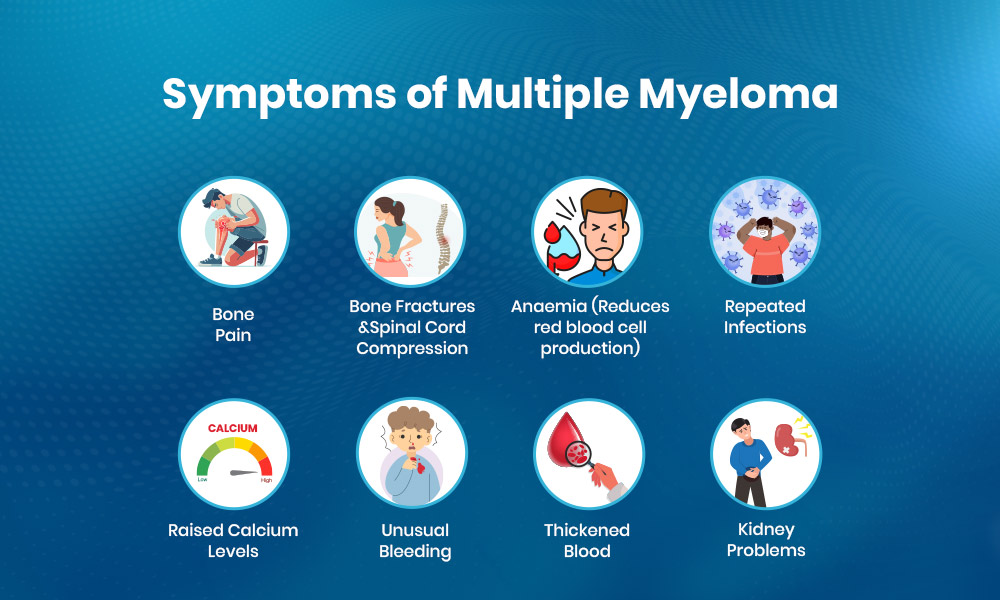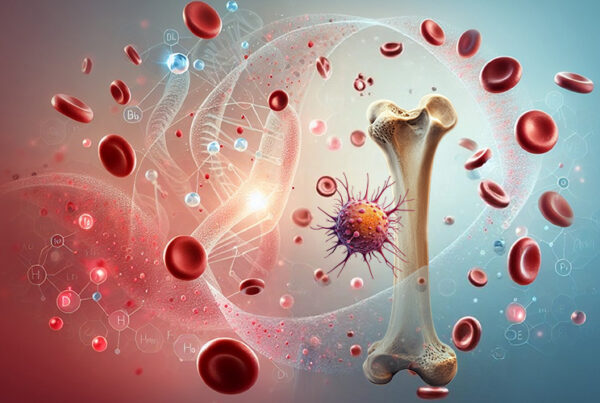
Multiple myeloma is a type of blood cancer that begins in plasma cells found in your bone marrow. Plasma cells normally help your body fight infections by creating antibodies. However, in multiple myeloma, these plasma cells turn cancerous and grow uncontrollably, crowding out healthy cells.
As the cancer spreads, it often affects several areas of the body, including the spine, ribs, pelvis, and skull. This is why it is called “multiple” myeloma. A key feature of this disease is the production of an abnormal protein called M protein, which can lead to further complications.
What Causes Multiple Myeloma?
The exact cause of multiple myeloma is unknown, but it is closely linked to a condition called monoclonal gammopathy of unknown significance (MGUS). MGUS involves having extra protein in the blood, but it doesn’t cause symptoms or require treatment.
However, about 1 in 100 people with MGUS develop multiple myeloma each year. There’s no way to prevent this, so people with MGUS are monitored regularly for signs of cancer. Multiple myeloma is more common in men, adults over 60, black individuals (twice as likely as white or Asian populations), and those with a family history of MGUS or myeloma.
Does Multiple Myeloma Run in Families?
A common question is, ‘Is Multiple Myeloma Hereditary?’ While the disease is not directly inherited, having a family history can increase your risk. For instance, if a parent or sibling has had multiple myeloma, your chances of getting it may be up to four times higher. However, this is rare and has only been observed in a small number of cases.
If you have concerns about your family history, consider speaking with a healthcare professional for personalized advice.
Symptoms of Multiple Myeloma
Bone Pain
- Commonly affects the back, ribs, or hips.
- Often a persistent dull ache, worsened by movement.
Bone Fractures & Spinal Cord Compression
- Weakened bones increase the risk of fractures, particularly in the spine and long bones.
- Spine fractures can collapse sections of the spine, causing pain and potential spinal cord compression.
Anaemia
- Reduces red blood cell production, leading to fatigue, weakness, and shortness of breath.
- Can be a side effect of myeloma treatment.
Repeated Infections
- Myeloma weakens the immune system, increasing susceptibility to frequent and long-lasting infections.
Raised Calcium Levels
- High calcium levels can lead to extreme thirst, stomach pain, frequent urination, and confusion.
- Requires urgent medical attention.
Unusual Bleeding
- Causes bruising, nosebleeds, and heavy periods due to reduced platelet production.
Thickened Blood
- In some cases, multiple myeloma can thicken the blood (hyperviscosity).
- It can cause blurred vision, headaches, dizziness, and bleeding.
Kidney Problems
- Can lead to kidney failure, with symptoms like weight loss, swollen limbs, fatigue, and shortness of breath.
- Immediate medical care is necessary.

Diagnosing Multiple Myeloma
Detecting multiple myeloma can be challenging because it’s a rare type of cancer that often shows few or no symptoms early on. However, a thorough diagnostic process helps confirm the condition.
General Examination and Initial Tests
During your visit, your General Physician will:
- Examine You: They will check for signs of infection, bleeding, and areas of bone tenderness.
- Review Your Medical History: They’ll discuss your symptoms, past health issues, and overall well-being.
- Order Initial Tests: Blood and urine tests may be done to check for abnormal proteins and antibodies linked to multiple myeloma.
If the results suggest multiple myeloma, your GP will refer you to a specialist.
Specialized Tests
You’ll be referred to a hematologist, a doctor who specializes in blood disorders, for additional testing.
Imaging Scans:
- CT or MRI scans will examine your arms, legs, skull, spine, and pelvis for bone damage caused by myeloma.
Bone Marrow Biopsy:
- This procedure confirms the diagnosis by checking for cancerous plasma cells.
- A small sample of bone marrow is taken, usually from the pelvis.
The samples are then analyzed in a lab to detect the presence of cancerous plasma cells.
Treatment Options for Multiple Myeloma
Multiple myeloma treatment depends on the disease stage and the presence of symptoms. Some cases may not require immediate intervention, while others necessitate prompt action to manage symptoms, control complications, and slow disease progression.
When Treatment May Not Be Needed
Smoldering Multiple Myeloma:
In its early stages, multiple myeloma may grow slowly and not cause symptoms. Doctors call this condition smoldering multiple myeloma.
Monitoring:
If treatment isn’t immediately necessary, your healthcare provider may recommend regular checkups. These typically include blood and urine tests to monitor for signs of disease progression.
Starting Treatment:
If symptoms develop or the condition worsens, you and your healthcare team will decide when to begin treatment.
Treatment Options
When treatment becomes necessary, the following options may be used based on your specific condition:
Targeted Therapy:
- Uses medicines to block specific chemicals in cancer cells.
- Causes cancer cells to die without affecting healthy cells.
Immunotherapy:
- Boosts your immune system’s ability to detect and destroy cancer cells.
CAR-T Cell Therapy:
- Modifies your T cells (a type of white blood cell) to target multiple myeloma.
- T cells are collected, treated in a lab, and reintroduced to fight cancer cells effectively.
Chemotherapy:
- Uses powerful medicines to kill fast-growing cancer cells.
- Often used in combination with other treatments.
Corticosteroids:
- Reduces inflammation and irritation in the body.
- Also works against myeloma cells.
Bone Marrow Transplant (Stem Cell Transplant):
A bone marrow transplant, or stem cell transplant, replaces damaged bone marrow with healthy cells.
- Autologous Transplant: Before a bone marrow transplant, stem cells are taken from your blood. After high-dose chemotherapy to destroy the diseased bone marrow, the healthy stem cells are returned to your body to rebuild the bone marrow.
- Allogenic Transplant: Uses stem cells from a donor to replace diseased bone marrow.
Radiation Therapy:
- Uses high-energy beams like X-rays to kill cancer cells.
- Radiation can shrink myeloma cell masses like plasmacytomas.
Why are Clinical Trials Important?
Clinical trials play a crucial role in advancing medical science and improving patient outcomes. They provide a controlled environment to test new treatments, medications, and therapies that could offer more effective solutions for diseases that currently lack comprehensive treatments. By participating in clinical trials, patients contribute to the development of breakthroughs that could ultimately transform care for future generations. Additionally, with the rise of decentralized clinical trials, patients can now participate from the comfort of their homes, reducing travel burdens and increasing accessibility.
Ongoing multiple myeloma clinical trials are exploring potential treatments to improve survival rates and quality of life. These trials may provide more personalized and effective options than traditional treatments.
Conclusion
In conclusion, while the exact cause of multiple myeloma remains unknown, factors like age, gender, and family history can increase the risk of developing the disease. Many wonder, “Is Multiple Myeloma Hereditary?” While the disease is not directly inherited, having a family history can slightly elevate the risk. Early detection through diagnostic tests is crucial for timely intervention and managing symptoms. Treatment options, including targeted therapies, immunotherapy, and stem cell transplants, aim to improve outcomes and quality of life for multiple myeloma patients. Clinical trials for cancer, such as those for multiple myeloma, are essential in advancing treatment options by providing access to innovative therapies and contributing to breakthroughs that may enhance care for future patients.







